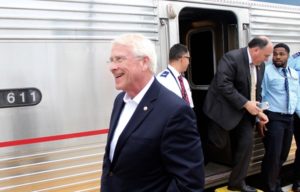WASHINGTON — Sixteen U.S. Senators have pushed back against Amtrak’s plan to reduce 12 daily long-distance trains to triweekly departures and cut its workforce by 20%.

The inquiries by nine Republicans and seven Democrats — representing Montana, North Dakota, West Virginia, Colorado, Nevada, Wisconsin, Mississippi, and Indiana — follow proposed Amtrak oversight legislation recently passed by the House Transportation and Infrastructure Committee.
Among recently added “managers amendments” to the “INVEST in America Act” [see “House committee releases new five-year transportation legislation,” Trains News Wire, June 5] before a floor vote are directives ordering Amtrak to maintain existing long-distance frequencies throughout the next fiscal year; provide ticket-selling and baggage-handling capability, not just agents, at 15 stations where Congressional appropriators had already demanded personnel be rehired; and ensure food service is available to all passengers and remains unchanged until a proposed Food and Beverage Working Group issues recommendations.
A letter obtained by Trains News Wire penned by U.S. Sen. Roger Wicker (R-Miss.), chairman of the Commerce, Science and Transportation Committee, asks to see what data Amtrak is using to justify long-distance reductions and the benchmarks that will trigger a specific plan for reinstating daily trains.
“We would like to ensure that reductions in frequencies for long-distance routes do not unnecessarily extend beyond the COVID-19 crisis,” it says.
U.S. Sen. Steve Daines (R-Mont.), who is up for re-election this year, and his six bipartisan co-signers say Amtrak’s proposal “raises serious doubts about whether a realistic plan exists for fully restoring service in a timely fashion.”
Triweekly service, his letter adds, “will eliminate thousands of points of connection and dramatically reduce the utility of Amtrak as a transportation provider, irrevocably hurting hundreds of communities and small towns already devastated by the COVID-19 pandemic.” The Daines letter, like Wicker’s, asks about metrics Amtrak will use to decide when daily service would return, but also wonders what Amtrak considers “adequate funding” that the company says it will need to restore frequencies.
Fellow Montana U.S. Sen. Jon Tester and Democrats from West Virginia and Nevada found the negative effects of reduced service and connections to rural communities such as Havre, Mont.; Elko, Nev.; and Prince, W. Va., “particularly egregious when Amtrak’s long-distance [trains] provided double the revenue of state-supported routes or the Northeast Corridor in May.” It also asks for conditions and timelines for restoring daily service, as well as “the costs associated with the reduction and resumption of service.”
Asked about the upcoming cuts in a Washington Post livestream interview Monday morning, Flynn did not the address cost or revenue impacts but said the Oct. 1 date was chosen because winter “is the time we have the lowest level of ridership on the long distance network. Then we will be evaluating those trains and other indicators, and our ability to restore service on a service-by-service plan as we come into the spring and … into the summer, which is the highest level of ridership.
“We’re looking at bookings and level of ridership; we’ll just have to look at where we are in terms of COVID-19 and the pandemic — God forbid there is a second wave. And we also want to understand Amtrak’s financial condition, and just broader level demand for Amtrak and air services, for example.” He said the company would “certainly” be communicating its criteria and plans for restoring long-distance service “to the representative committees and very interested members on [Capitol] Hill.”














